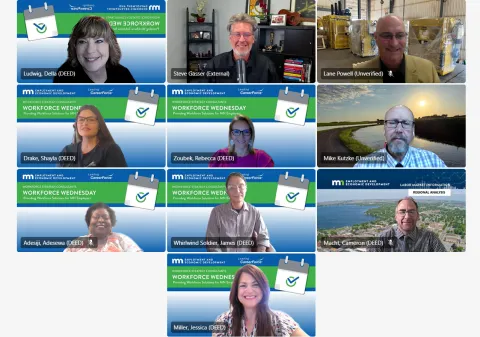
Artificial intelligence (AI) is constantly in the headlines, sparking both excitement and apprehension. For many Minnesota employers, the big questions remain: What exactly is AI? How can it apply to my business? And could it mean for my workforce – and my bottom line?
These were precisely the questions addressed in the July 2025 Workforce Wednesday session, "Introduction to AI for Employers: What It Is, How It Works, and Why It Matters." The session provided a foundational understanding of AI, explored its applications across various industries, and delved into the opportunities and challenges it presents for the workforce. We even heard from Minnesota employers already exploring AI's potential.
This article is the first in a three-part series, written with the assistance of AI, covering what was discussed during the Workforce Wednesday session in July. AI is a hot topic in general and is clearly of high interest to Minnesota employers: 416 people attended July’s session. This blog series will break down what was covered on the session, but you are also invited to visit the Workforce Wednesday archive to watch a recording of the session, download a PDF of the presentation materials and access related resources.
AI Fundamentals: More Than Just a Buzzword
Mike Kutzke, Vice President for Student Success from Ridgewater College kicked off the session by demystifying AI. He emphasized a few crucial points:
- AI Isn't New, Access Is: While AI has been around for decades, public access to powerful tools like ChatGPT is a recent development, opening up possibilities for everyone.
- AI Recognizes Patterns: At its core, AI is software that excels at recognizing patterns in vast amounts of data. It can sift through information and identify connections far more efficiently than humans.
- The Power of Both: The most important takeaway? AI isn't about technology or people; it's about technology AND people. AI can generate results, but human interpretation, application, and the personal touch remain essential. Our attitude and interaction with AI significantly influence outcomes.
- Rapid Evolution: AI is not static; it's doubling in power every 3.3 months. This means the landscape is constantly shifting, and what might have been a challenge six months ago could already be resolved or improved.
- Embedded in Daily Life: You're likely already using AI without realizing it – think Siri, Alexa, navigation apps, or Grammarly. AI is becoming increasingly embedded in various aspects of our lives.
- Augmentation, Not Replacement: AI should be viewed as a supplemental tool, not a replacement for human work. It can significantly increase productivity, in part by reducing repetitive work.
Exploring the Different Types of AI
Mike highlighted four common types of AI, each with distinct uses:
- Generative AI: This is what most people associate with AI right now. It's used to create new content, whether it's writing emails, editing documents, or generating images and even videos.
- Predictive AI: This type of AI analyzes data patterns to make predictions. Imagine using AI to analyze decades of stock market data to inform investment decisions – that's predictive AI at work.
- Conversational AI (Natural Language Models): This is a game-changer for many. Instead of complex prompts, you can simply have a conversation with the AI, asking follow-up questions and refining your requests in natural language. Tools like ChatGPT, Copilot, and Claude offer this interactive experience.
- Agentic AI: This allows users to create AI "agents" that perform tasks in the background with minimal human intervention. These agents can gather information, process it, and provide what you need, making them incredibly powerful for automation.
Choosing the Right AI Tool
Just like traditional tools, each AI tool has its strengths and weaknesses. Mike touched on a few popular ones:
- Microsoft Copilot: Designed for enterprise use, Copilot keeps your data internal and has lower rates of "hallucinations" (AI making up information). It's built to be a business backbone.
- ChatGPT (OpenAI): This free tool (with paid versions available) is highly intuitive and excellent for learning the ropes of AI. However, information you input may be used to further train its language models.
- Claude (Anthropic): Claude excels at writing and deep research, making it ideal for projects like grant writing.
- Google Gemini: Features like Gemini's "notebook" offer powerful capabilities for organization and interaction.
While free versions offer significant functionality, paid subscriptions generally provide more access and fewer limitations on usage.
Addressing AI Concerns: A Balanced View
It's important to acknowledge the valid concerns surrounding AI:
- Environmental Impact: Large data centers required for AI consume vast amounts of energy and water, raising sustainability concerns.
- Skill Development: Will over-reliance on AI diminish critical thinking and writing skills?
- Privacy Issues: Information entered into public AI tools can become accessible to others.
- Hallucinations: AI can sometimes generate inaccurate or fabricated information, though some tools are designed to minimize this.
- Bias: AI models are trained on existing data, which can reflect historical biases in information creation. It's crucial to be aware of this and, where possible, specify diverse sources for information.
The Road Ahead
AI is a rapidly evolving force that will undoubtedly reshape our workplaces. By understanding its fundamentals, exploring its various applications, and addressing potential concerns, Minnesota employers can strategically plan for workforce development, leverage AI for innovation, and prepare their teams for a future where human ingenuity and artificial intelligence work hand-in-hand.

